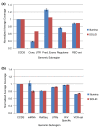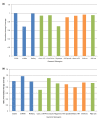Targeted enrichment beyond the consensus coding DNA sequence exome reveals exons with higher variant densities
- PMID: 21787409
- PMCID: PMC3218830
- DOI: 10.1186/gb-2011-12-7-r68
Targeted enrichment beyond the consensus coding DNA sequence exome reveals exons with higher variant densities
Abstract
Background: Enrichment of loci by DNA hybridization-capture, followed by high-throughput sequencing, is an important tool in modern genetics. Currently, the most common targets for enrichment are the protein coding exons represented by the consensus coding DNA sequence (CCDS). The CCDS, however, excludes many actual or computationally predicted coding exons present in other databases, such as RefSeq and Vega, and non-coding functional elements such as untranslated and regulatory regions. The number of variants per base pair (variant density) and our ability to interrogate regions outside of the CCDS regions is consequently less well understood.
Results: We examine capture sequence data from outside of the CCDS regions and find that extremes of GC content that are present in different subregions of the genome can reduce the local capture sequence coverage to less than 50% relative to the CCDS. This effect is due to biases inherent in both the Illumina and SOLiD sequencing platforms that are exacerbated by the capture process. Interestingly, for two subregion types, microRNA and predicted exons, the capture process yields higher than expected coverage when compared to whole genome sequencing. Lastly, we examine the variation present in non-CCDS regions and find that predicted exons, as well as exonic regions specific to RefSeq and Vega, show much higher variant densities than the CCDS.
Conclusions: We show that regions outside of the CCDS perform less efficiently in capture sequence experiments. Further, we show that the variant density in computationally predicted exons is more than 2.5-times higher than that observed in the CCDS.
Figures







References
Publication types
MeSH terms
Grants and funding
LinkOut - more resources
Full Text Sources
Other Literature Sources
Miscellaneous

